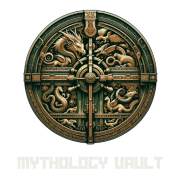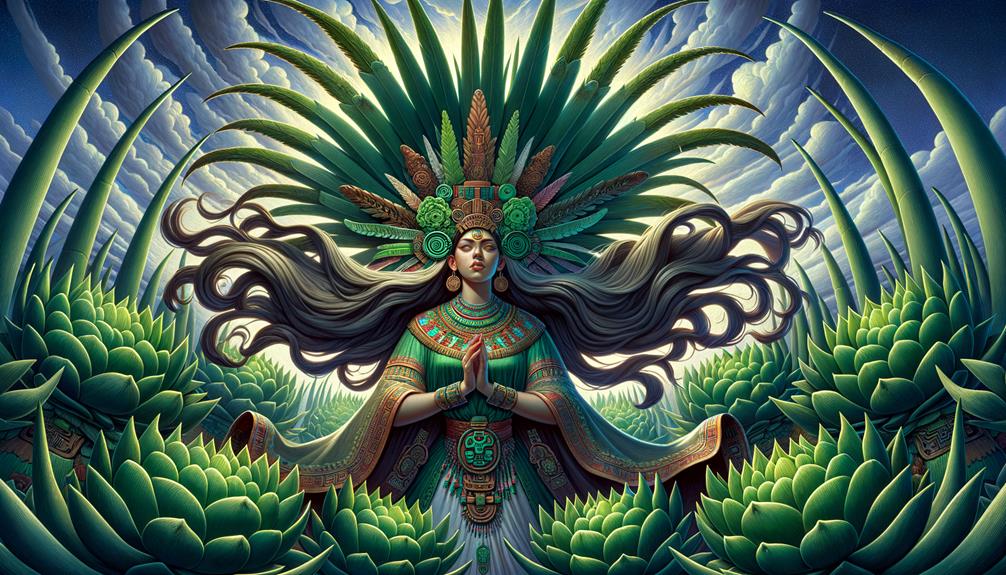When examining the Mayahuel myth, the tale of the Maguey Goddess, a profound narrative emerges interwoven with symbolic fertility and sacrifice imagery. Her romantic union with Ehecatl, the wind deity, represents vital elemental force interplay sustaining life's renewal cycles. Mayahuel's eventual transformation into an agave plant following her sacrifice highlights the regenerative capacity inherent in selflessness. This myth encapsulates the Aztecs' profound reverence for nature's cycles, yet an even deeper layer remains unexplored within her narrative.
Mythological Origins
Mayahuel's mythological tale reveals profound connections between Aztec culture and the maguey plant. As the goddess embodying the maguey's fertility and abundance, her narrative unravels archetypal symbols pivotal to the civilization.
The myth recounts Mayahuel's kidnapping by the Tzitzimitl, celestial forces representing chaos. Her rescue by Ehecatl, a form of Quetzalcoatl, triggers her transformation into the maguey plant. This heroic journey and subsequent metamorphosis mirror cycles of growth and renewal central to Aztec worldviews.
Mayahuel's rebirth as the maguey plant is inseparable from the genesis of pulque, the traditional alcoholic beverage derived from the plant. Her story echoes the maguey's vital role in sustaining life and spirituality for the Aztecs.
Through Mayahuel's myth, the Aztecs intertwined their understandings of agricultural cycles, fertility rites, and cosmic balance. Her transformation evokes continuity amidst constant change, a metaphor crystallizing their belief systems.
Mayahuel and Ehecatl
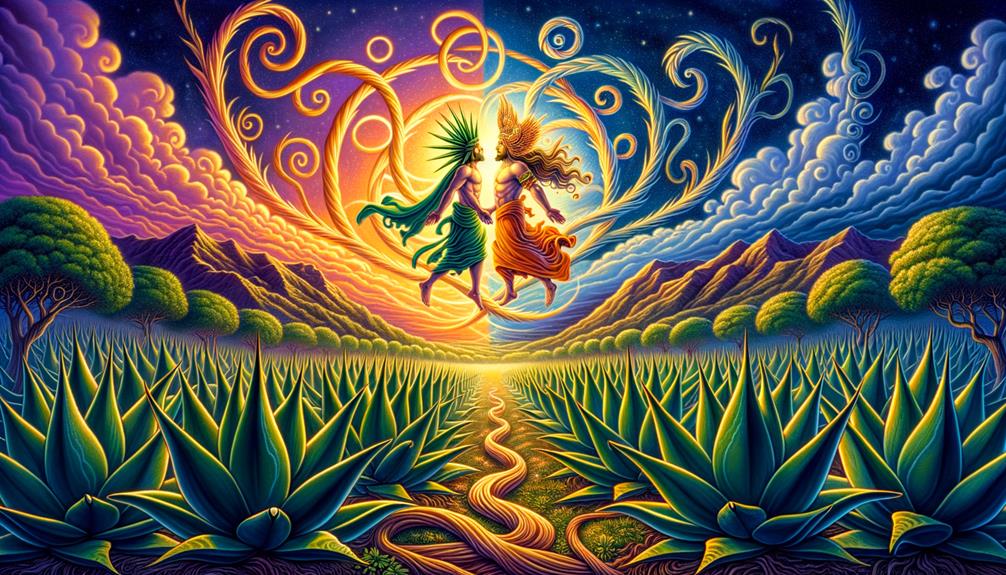
The love between Mayahuel and Ehecatl encapsulates the interconnected forces that govern the natural world in Aztec mythology. At its core, their narrative illustrates the profound bond between growth and movement. Mayahuel, the maguey goddess, found herself enamored with Ehecatl, the wind deity. This romantic alliance symbolized the harmonious collaboration of divine elements.
Driven by affection, Ehecatl rescued Mayahuel from captivity, bringing her to Earth. Their relationship depicts the synergy between wind and fertility – both crucial for the maguey plant's flourishing. While Ehecatl embodied constant change and motion, Mayahuel represented nourishment and regeneration. United, they formed a powerful archetype of transformation within the cycle of life.
This tale goes beyond explaining the maguey's origins; it reflects the delicate equilibrium and eternal renewal inherent in nature. By intertwining love with divine forces, Mayahuel and Ehecatl's narrative gracefully captures the symbiotic relationship between the natural world and divine entities in Aztec cosmology.
Transformation Into Agave
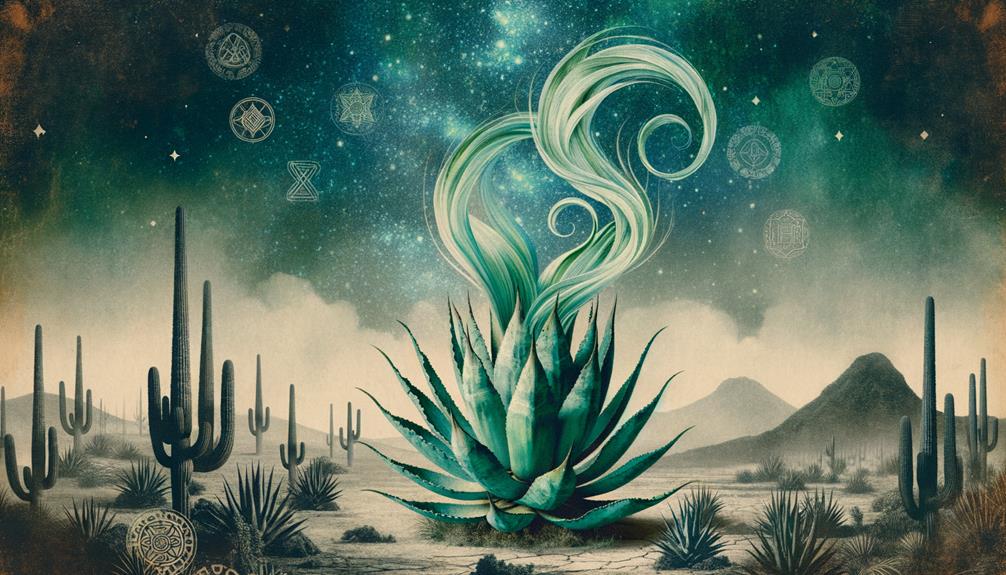
Mayahuel and Ehecatl's love story takes a dramatic turn when Mayahuel, pursued by the malicious Tzitzimitl, is torn apart. This tragic moment symbolizes the ultimate sacrifice, reflecting the archetypal cycle of life and death. Mayahuel, the goddess of fertility, undergoes fragmentation but is reborn through the maguey plant, commonly known as the agave.
The maguey plant emerges as a symbol of sustenance. Mayahuel's essence infuses the agave, solidifying her significance in Mexican mythology. The plant's role in producing pulque, a sacred drink, highlights her crucial connection to fertility and nourishment. This bond between the goddess and the maguey underscores nature's cyclical renewal.
Through her transformation, Mayahuel embodies nature's regenerative power, cementing her status as a fertility deity. Her story, interwoven with cultural heritage, reminds us of the eternal cycle – life, death, and rebirth – and her lasting presence in the maguey plant.
Symbolism and Fertility
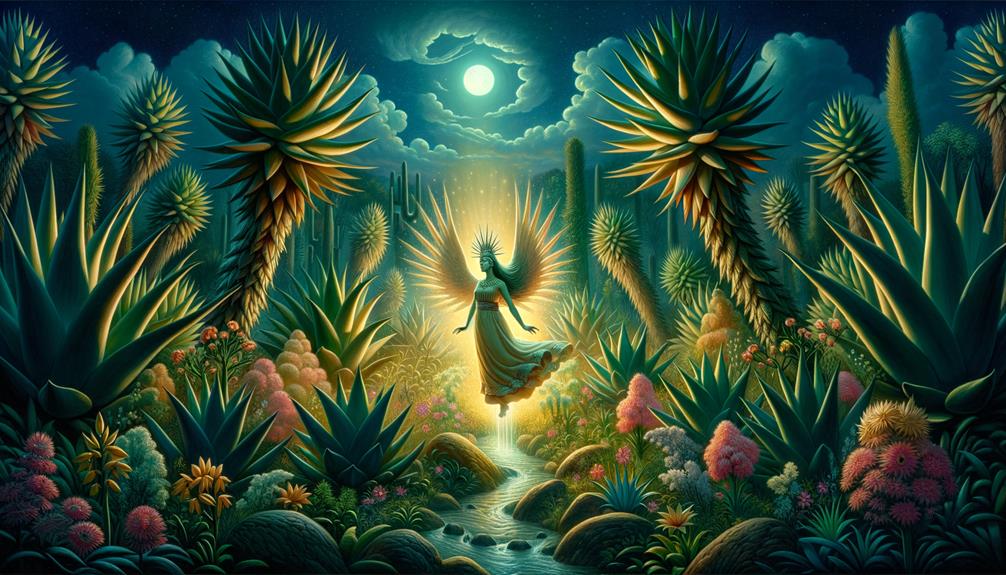
Mayahuel embodies fertility, acting as a nurturing force through her deep connection to the maguey plant, representing life's abundance and renewal. In Aztec myths, her multiple breasts symbolize her role in providing sustenance and enabling fertility. This imagery ties her to the maguey plant, which was a vital source of resources like pulque, a revered alcoholic beverage.
The maguey's growth cycles mirror nature's rhythms of life, death, and rebirth, underscoring Mayahuel's part in these recurring patterns. As the plant thrives, so does her influence, ensuring the earth's bounty. This cyclical aspect highlights the patterns of fertility and renewal that make her vital.
Mayahuel's story weaves nurturing and abundance themes. Her presence affirms the importance of fertility deities in ancient belief systems, emphasizing respect for the earth's divine gifts.
Cultural Significance
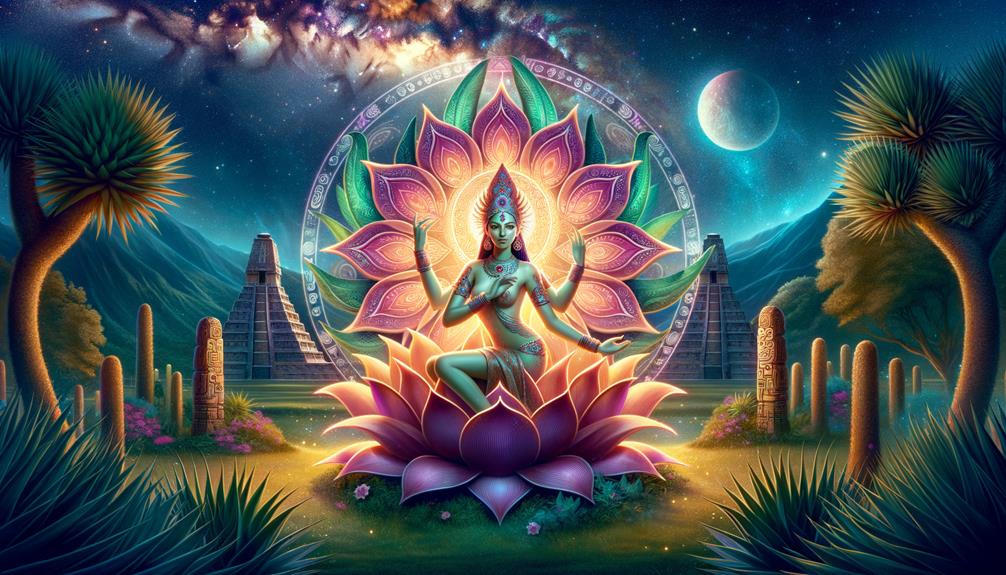
The Aztecs revered Mayahuel, the maguey goddess embodying fertility and sustenance. Mayahuel's legend intertwines with their society's cultural identity through the iconic beverages pulque and mezcal, crafted from the sacred maguey plant.
Pulque, fermented maguey sap, wasn't simply a drink but a ritualistic pathway connecting the Aztecs to their gods. Through pulque, they sought Mayahuel's blessings of abundance. Similarly, mezcal, dubbed the "Elixir of The Gods," highlighted Mayahuel's divinity and her people's devotion.
Mayahuel's mythology intersects notable figures like Quetzalcoatl, reflecting her importance in preserving cosmic harmony and cultural traditions. Her narrative symbolizes the Aztecs' profound reverence for the maguey's life-giving gifts, transcending mere legend to become an eternal thread woven into their collective spirit.
Frequently Asked Questions
What Is Mayahuel the Goddess Of?
Maguey plants offer a wealth of sustenance, with 80% of their uses dedicated to nourishment. Mayahuel, the deity associated with this versatile crop, symbolizes fertility, provision, and life's cyclical rhythms. Her story weaves a narrative of transformation and abundance, echoing the hero's journey.
Who Is the Lady of Maguey?
The maguey lady symbolizes fertility and transformation in Mexican culture. Her story represents the hero's journey – love and sacrifice lead to rebirth, teaching about life's abundance and cycles. The legend paints her as an embodiment of new beginnings and resilience against adversity. Through hardship comes renewal, just as the maguey plant regenerates after harvesting. Her tale encourages hope and appreciating nature's gifts. This poetic archetype resonates with the human experience, offering inspiring lessons.
Who Is the Mexican Goddess of Tequila?
Mayahuel, the goddess of tequila in Mexican culture, represents fertility and sustenance. Her mythical journey involves transforming into the maguey plant, symbolizing life's cyclical nature deeply rooted in agriculture. This connection to the land resonates with traditions centered around nurturing spirits and resources.
What Were the Children of a Goddess of Maguey Called?
The maguey goddess's offspring carried the name Centzon Totochtin, symbolizing 400 rabbits. Akin to mythical gatekeepers of intoxication, they embodied pulque's transformative potency, guiding revelers through altered states.
